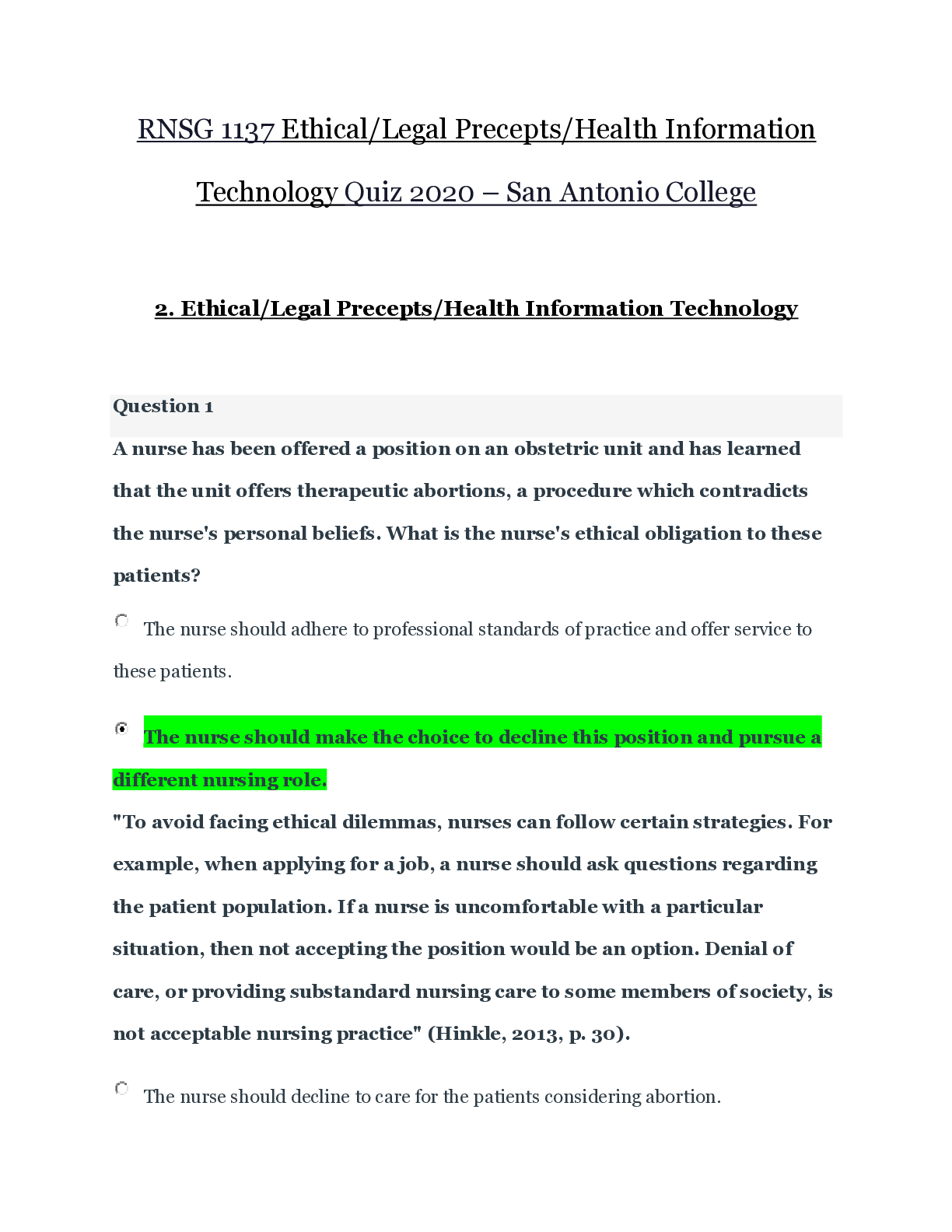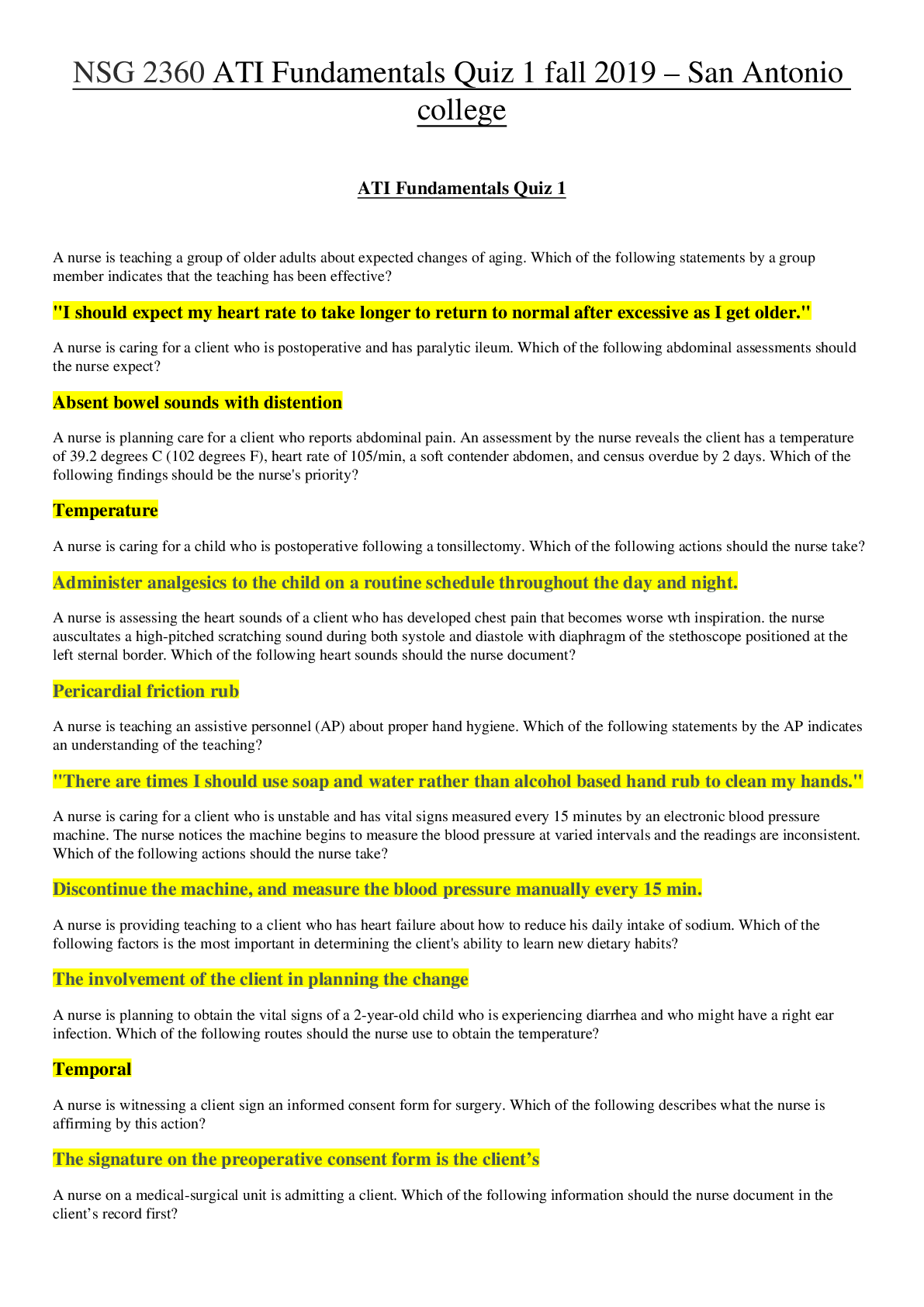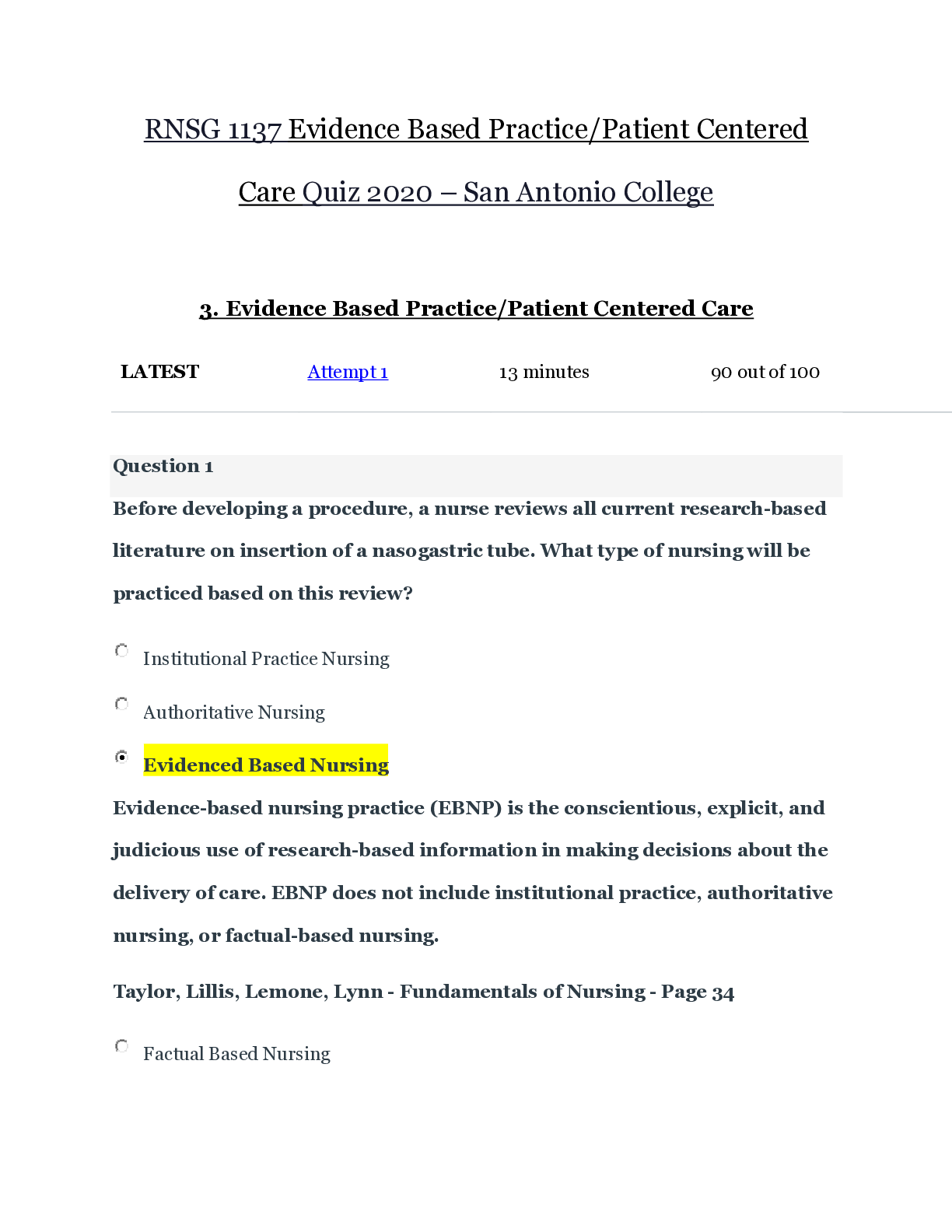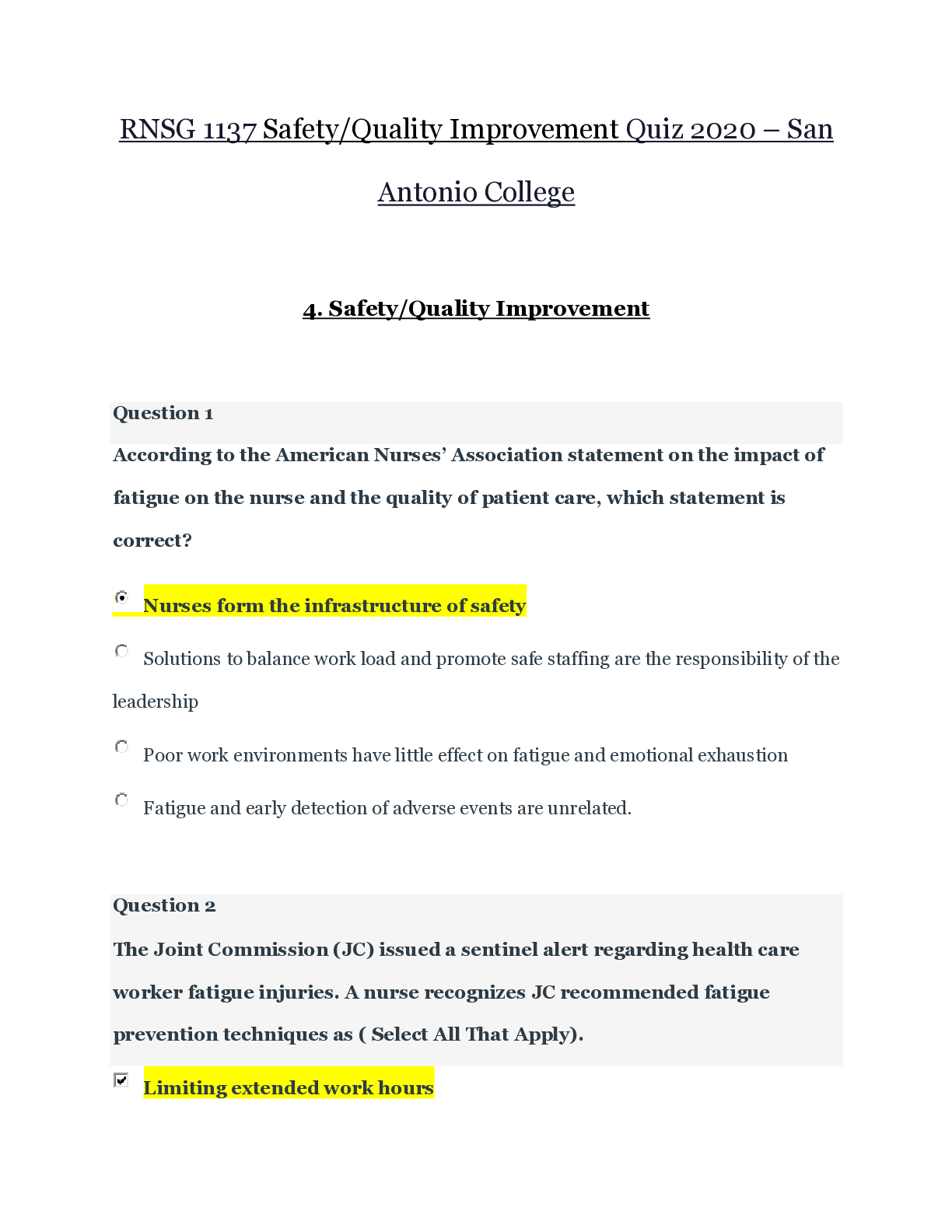*NURSING > EXAM > RNSG 1137 Ethical/Legal Precepts/Health Information Technology Quiz 2020 – San Antonio College | R (All)
RNSG 1137 Ethical/Legal Precepts/Health Information Technology Quiz 2020 – San Antonio College | RNSG1137 Ethical/Legal Precepts/Health Information Technology Quiz 2020
Document Content and Description Below
RNSG 1137 Ethical/Legal Precepts/Health Information Technology Quiz 2020 – San Antonio College 2. Ethical/Legal Precepts/Health Information Technology Question 1 A nurse has been offered a ... position on an obstetric unit and has learned that the unit offers therapeutic abortions, a procedure which contradicts the nurse's personal beliefs. What is the nurse's ethical obligation to these patients? The nurse should adhere to professional standards of practice and offer service to these patients. The nurse should make the choice to decline this position and pursue a different nursing role. "To avoid facing ethical dilemmas, nurses can follow certain strategies. For example, when applying for a job, a nurse should ask questions regarding the patient population. If a nurse is uncomfortable with a particular situation, then not accepting the position would be an option. Denial of care, or providing substandard nursing care to some members of society, is not acceptable nursing practice" (Hinkle, 2013, p. 30). The nurse should decline to care for the patients considering abortion. The nurse should express alternatives to women considering terminating their pregnancy. Question 2 An adult patient has requested a “do not resuscitate” (DNR) order in light of his recent diagnosis with late stage pancreatic cancer. The patient's son and daughter-in-law are strongly opposed to the patient's request. What is the primary responsibility of the nurse in this situation? Perform a “slow code” until a decision is made. Contact a social worker or mediator to intervene. Temporarily withhold nursing care until the physician talks to the family. Honor the request of the patient. The ethical principle of autonomy is the responsibility to "respect the rights of patients or their surrogates to make health care decisions" (Taylor, 2014, p. 97). Question 3 Which of the following actions by the nurse is consistent with the ethical principle of nonmaleficence? Refusing to administer pain medication as ordered Not answering a call bell because you are passing medications Prioritizing care and providing more care for one patient than for another as necessary. The ethical principle of non-maleficence is defined as "seek not to inflict harm; seek to prevent harm or risk of harm whenever possible" (Taylor, 2014, p. 97). Letting an IV infusion continue despite the patient complaining of pain at the site Question 4 The Electronic Medical Record (EMR) is the patient care record created when agencies under different ownership share their data. The goal is for this sharing to be nationwide, creating a situation in which a person’s health care record is accessible by designated health care providers anywhere in the nation. The patient will decide which portions of a record will be available to whom. True or False? True False "An EMR is an electronic patient care record created by an agency or agencies having common ownership. Although these EMRs today are often called EHRs, they are not true EHRs because the data is not shared between providers in agencies under different ownership" (Taylor, 2014, p. 341). Question 5 A nurse is refusing to care for a patient because he has AIDS. The nurse has an obligation to care for this patient under which legal premise? Good Samaritan Act Patient Self-Determination Act ANA Code of Ethics "The ethical obligation to care for all patients is clearly identified in the first statement of the Code of Ethics for Nurses (ANA, 2001a). Lachman (2009) asserts, “As a professional, the nurse is expected to reflect and move beyond feelings to provide the same level of care to every patient, regardless of diagnosis, skin color, ethnic origin, or economic status” (p. 55). To avoid facing ethical dilemmas, nurses can follow certain strategies. For example, when applying for a job, a nurse should ask questions regarding the patient population. If a nurse is uncomfortable with a particular situation, then not accepting the position would be an option. Denial of care, or providing substandard nursing care to some members of society, is not acceptable nursing practice" (Hinkle & Cheever, 2013, p. 30). Texas Board of Nursing Policy Question 6 What ethical violation is most often posed when using restraints in a long-term care setting? It limits the patient's personal safety. It causes too much anxiety in patients. It threatens the patient's autonomy. "The use of restraints (including physical and pharmacologic measures) is another issue with ethical overtones because of the limits on a person’s autonomy when restraints are used." (Hinkle & Cheever, p. 29). It is illegal regardless of the circumstance. Question 7 According to the article “Alarm Fatigue: A Patient Safety Concern,” Sendelbach and Funk assert that factors associated with alarm fatigue include which of the following? Select All That Apply Desensitization towards multiple alarm Inexperience of nursing staff False alarms Alarm volume set too loudly Increased number of alarms Question 8 A nurse is documenting the intensity of a patient's pain. What would be the most accurate entry? Patient is complaining of severe pain Patient appears to be in a lot of pain as evidenced by crying Patient states he is in severe pain rated at a 9 on a scale of 0-10 "Avoid generalizations such as “seems comfortable today.” A better entry would be “on a scale of 1 to 10, patient rates back pain 2 to 3 today as compared with 7 to 9 yesterday; vital signs returned to baseline" (Taylor, 2014, p. 342). Patient is in pain and will medicate per orders Question 9 What is the primary purpose of the patient record? Communication "The primary purpose of the patient record is to help health care professionals from different disciplines (who interact with the patient at different times) communicate with one another. Communication fosters continuity of care. For example, a critically ill patient in an academic health center may be seen by an attending physician, several consulting physicians, different teams of residents, an assigned social worker or case manager, assorted therapists, a hospital chaplain, and many nurses" (Taylor, 2014, p. 345). Education Research Patient advocacy Question 10 0 / 10 pts Which one of the following methods of documentation is organized around patient diagnoses rather than around patient information? Problem-oriented medical record Source-oriented record Focus charting PIE charting [Show More]
Last updated: 2 years ago
Preview 1 out of 7 pages

Buy this document to get the full access instantly
Instant Download Access after purchase
Buy NowInstant download
We Accept:

Reviews( 0 )
$9.50
Can't find what you want? Try our AI powered Search
Document information
Connected school, study & course
About the document
Uploaded On
Nov 07, 2020
Number of pages
7
Written in
Additional information
This document has been written for:
Uploaded
Nov 07, 2020
Downloads
0
Views
84








 – University of the People.png)












 – San Antonio College.png)




